C2.2 Neural signalling SL
1/62
There's no tags or description
Looks like no tags are added yet.
Name | Mastery | Learn | Test | Matching | Spaced |
|---|
No study sessions yet.
63 Terms
Neurons
Cells within the nervous system that carry electrical impulses
Nerve cells
Nerve impulse
Electrical signal passed betw 2 cells
Can pass along / between neurons
Electric impulse (double check)
Movement of positively charged ions across the axon
2 groups of nerve impulses
Transmission ALONG neurons
Transmission BETWEEN neurons
What makes up the cell body of a neuron?
Cytoplasm
A nucleus
Elongated nerve fibres of varying length projecting from it
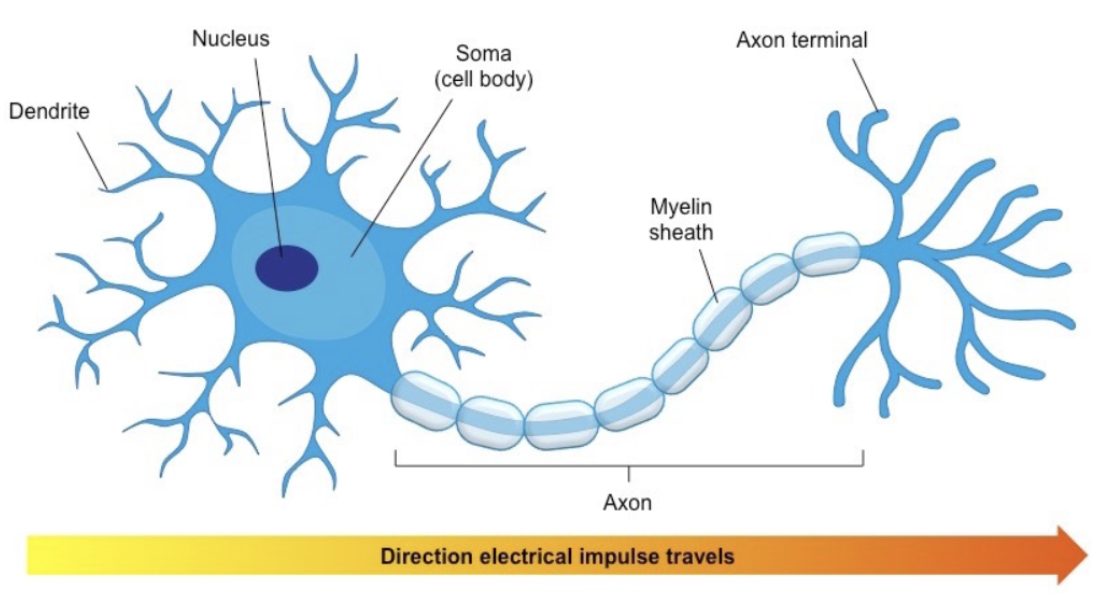
Axon
A long single fibre
Dendrites
Multiple shorter nerve fibres
What are electrical impulses conducted along?
Axons + dendrites
What do receptors do to stimuli?
Convert stimuli into electrical signals
What do effectors do to electric signals?
Convert the electrical signals into a response
3 types of neurons
Sensory
send impulses to the CNS
Motor
send impulses from the CNS
Relay
send impulses within the CNS
Membrane potential
Voltage created by an imbalance of charges (ions) on either side of the membrane
Either relatively positive or negative
Resting membrane potential
-70mV
Inside of neuron relatively negative
When the neuron is at rest
Location of sodium + potassium ions during resting membrane potential
Na ions outside the cell
K ions inside
What generates the resting potential?
Pumping → to establish + maintain concentration gradients of Na + K ions
How does the sodium-potassium pump generate the resting potential?
Energy from ATP drives the pumping of Na + K ions in opposite directions across the plasma membrane of neurons
Actively transports Na ions to the outside + K ions to the inside of the cell
Need ATP to generate a CG
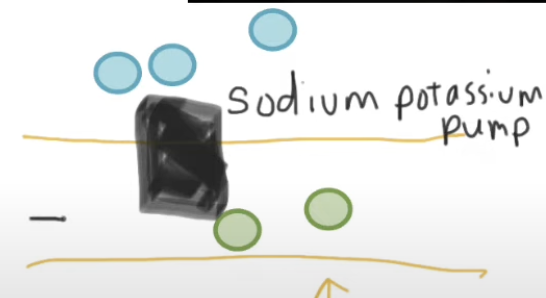
Why is resting potential negative? (double check)
3 Na+ leave the cell, but only 2 K+ enter → more positively charged ions leaving → interior of cell relatively negative to outside
3 things that maintain resting potential?
Sodium-potassium pumps: 3 Na+ out, 2 K+ in via AT
Leakage of K+ ions back across the
membrane by facilitated diffusion
Negatively charged ions (Cl-) fixed inside the axon
Is a nerve impulse electrical or chemical?
Electrical
Why is a nerve impulse electrical?
Involves movement of positively charged ions
Membrane polarization (DOUBLE CHECK DEFINITION)
The difference in electrical charge across the cell membrane, where the inside of the cell is more negative than the outside (resting potential)
Imp for generating action potentials during nerve impulse transmission
Depolarization
Membrane potential goes from negative to positive
Due to movement of postitive ions (Na+ moving into the cell)
Change from resting to action potential
Repolarization
Membrane potential goes from positive back to negative
Due to movement of positive ions (K+ moving out of the cell)
Action → resting potential

Steps of nerve transmission + establishing resting potential
Voltage-gated Na ion channels open
Na ions diffuse into the cell (facilitated diffusion)
Causes depolarisation (- to +)
Bc Na ions = positively charged
Inside relatively positive → voltage-gated Na ion channels close + voltage-gated K ion channels open
K ions diffuse out of the cell (facilitated diffusion)
Repolarisation (+ to -)
Inside of cell relatively negative
BUT at this point, K+ outside, Na+ inside → needs to be other way
Sodium potassium pump re-establishes resting potential by actively pumping Na ions out + K in
idk
1. The sodium-potassium pump binds to three sodium ions from
the intracellular side of the membrane.
2. The sodium-potassium pump is phosphorylated using a
phosphate from ATP.
3. The sodium-potassium pump changes shape and moves the
sodium ions to the extracellular side.
4. The sodium-potassium pump can now bind to two potassium
ions.
5. The potassium ions are released into the intracellular side.
6. The phosphate is released, and the sodium-potassium pump
reverts back to its original shape.
7. This is an example of active transport as the sodium and
potassium ions are being moved against their concentration
gradient.
8. As a result, there are more sodium ions outside the
membrane and more potassium ions inside the membrane.
9. However, movement of potassium ions is reduced as they are
attracted to other native anions inside the axon.
10. This means that there is an electrochemical gradient
established.
11. Some potassium ion channels are open so some potassium
ions can diffuse through the membrane from inside to outside.
12. Sodium ion channels are not open, so no sodium ions can
diffuse through the membrane from outside to inside.
13. Therefore, overall, there is a more negative charge inside the
cell, and the resting potential is established (~70 mV).
Action potential
The potential electrical difference produced across the axon membrane when a neuron is stimulated
Involves rapid movement of Na ions + K ions across the membrane of the axon
2 stages- depolarisation + repolarisation
Nerve impulses in relation to action potentials
Nerve impulses = action potentials that are propagated along nerve fibres
Feature of nerve impulses related to propogation
Self propagating
Self-propagating
Depolarisation in 1 part triggers depolarization in the next part (along the axon) due to the opening of voltage-gated channels

How many directions does nerve transmission happen in?
1
Start: dendrite
Moves along axon
End: exon terminal
When is a neuron membrane said to be polarised?
Once resting potential is reached
What needs to happen to the neuron membrane to initiate a nerve impulse in a neuron?
Neuron membrane needs to be depolarised
Reversal of the electrical potential difference across the membrane
When does the depolarisation of the membrane occur?
When an action potential is generated
Average speed for nerve impulse
1 m/s
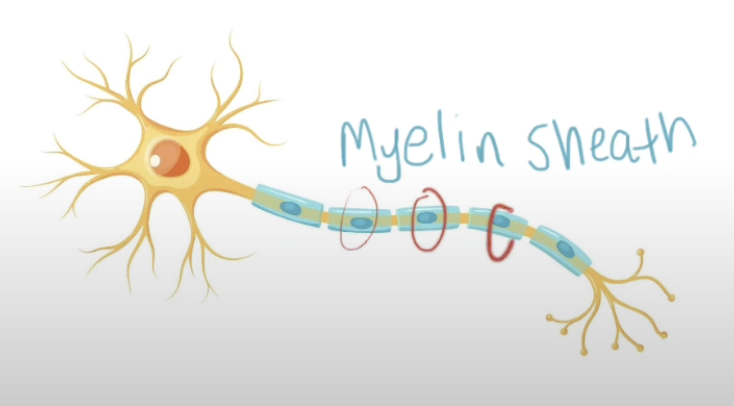
Adaptations to increase the speed of nerve impulses
Increase axon diameter
Myelination
Factors affecting speed of nerve impulses
Space in between the myelin sheath
Nodes
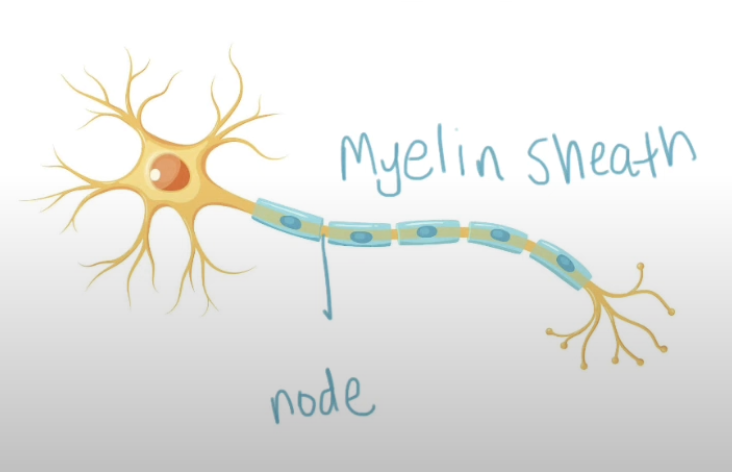

How do myelin sheaths increase the speed of nerve impulses?
They insulate the electrical charge
Electrical charge only jumps at nodes (Na+ in and out, K+ in and out only at nodes)
So less energy needed (to power Na K pump) + increases speed
Compare the speed of transmission in giant axons of squid and smaller non-myelinated nerve fibres

Also compare the speed of transmission in myelinated + non-myelinated fibres

APPLICATION OF SKILLS
Students should be able to describe negative and positive correlations and apply correlation coefficients as a mathematical tool to determine the strength of these correlations.
Students should also be able to apply the coefficient of determination (R2 ) to evaluate the degree to which variation in the independent variable explains the variation in the dependent variable.
Conduction speed of nerve impulses is … correlated with animal size
Conduction speed of nerve impulses is … correlated with axon diameter.
Negatively
Positively
Synapse
Junctions betw:
Neurons
Neurons + effector cells
Here signals are passed by chemical neurotransmitters
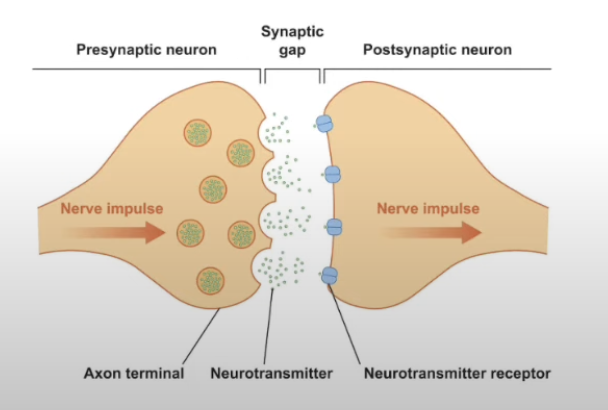
Across a typical synapse, how many directions can a signal pass in?
1
2 main steps of synaptic transmission (transmission between neurons)
Release of neurotransmitters from a presynaptic membrane
Generation of an excitatory postsynaptic potential
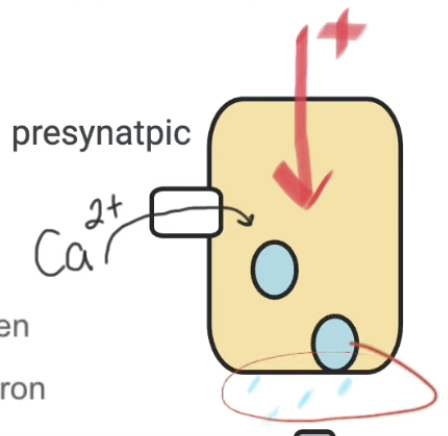
Steps of transmission between neurons- synaptic transmission (part 1, presynaptic neuron)
Action potential reaches the end of the presynaptic neuron
Voltage gated calcium ion channels open
Ca ions enter the preS neuron via facilitated diffusion
Bc high conc of Ca ions outside
Ca ions force vesicles with neurotransmitters to fuse with the membrane
Neurotransmitters are released into the synapse (exocytosis)
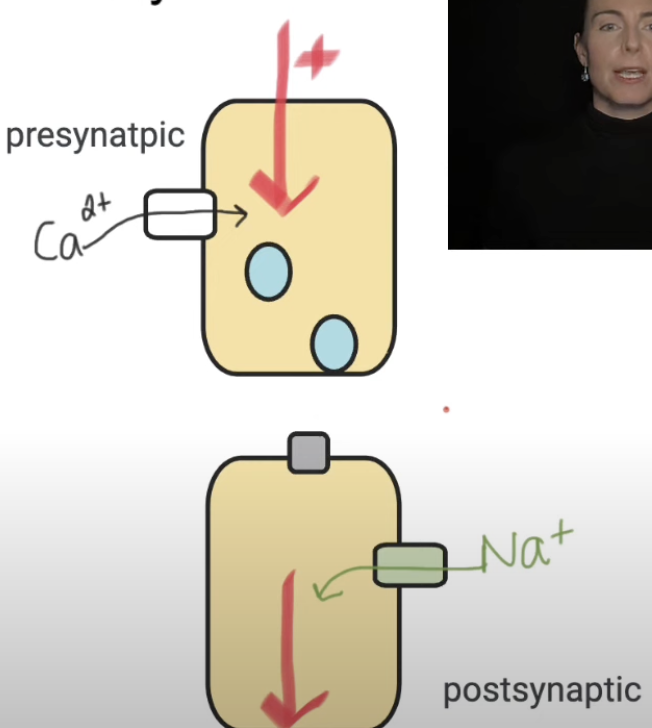
Steps of transmission between neurons- synaptic transmission (part 2, postsynaptic neuron)
Neurotransmitters diffuse across the synapse
Binds to complementary receptor on the postS membrane
Na ion channels open
Na ions enter postS neuron via facilitated diffusion
If enough ions enter the postS cell → generates an action potential
Neurotransmitter removed from synapse
Why do neurotransmitters need to be removed from the synapse?
Prevents constant stimulation of the post-synaptic cell + an excessive firing of action potential
From spec
Uptake of calcium in response to depolarization of a presynaptic membrane
It is a signalling chemical inside a neuron
Neurotransmitters diffuse across the synaptic cleft
Binding to transmembrane receptors
Acetylcholine
Neurotransmitter betw motor neurons + muscles
Examples of synapses where the neurotransmitter acetylcholine exists
Neuromuscular junction
class work
Importance of synapses + why is this beneficial?
Ensures 1 way transmission of impulses
Prevents impulses from travelling the wrong way
How do synapses ensure 1 way transmission
Neurotransmitter is released on 1 side + its receptors are on the other
Explain fully how a resting potential is generated in a neurone.
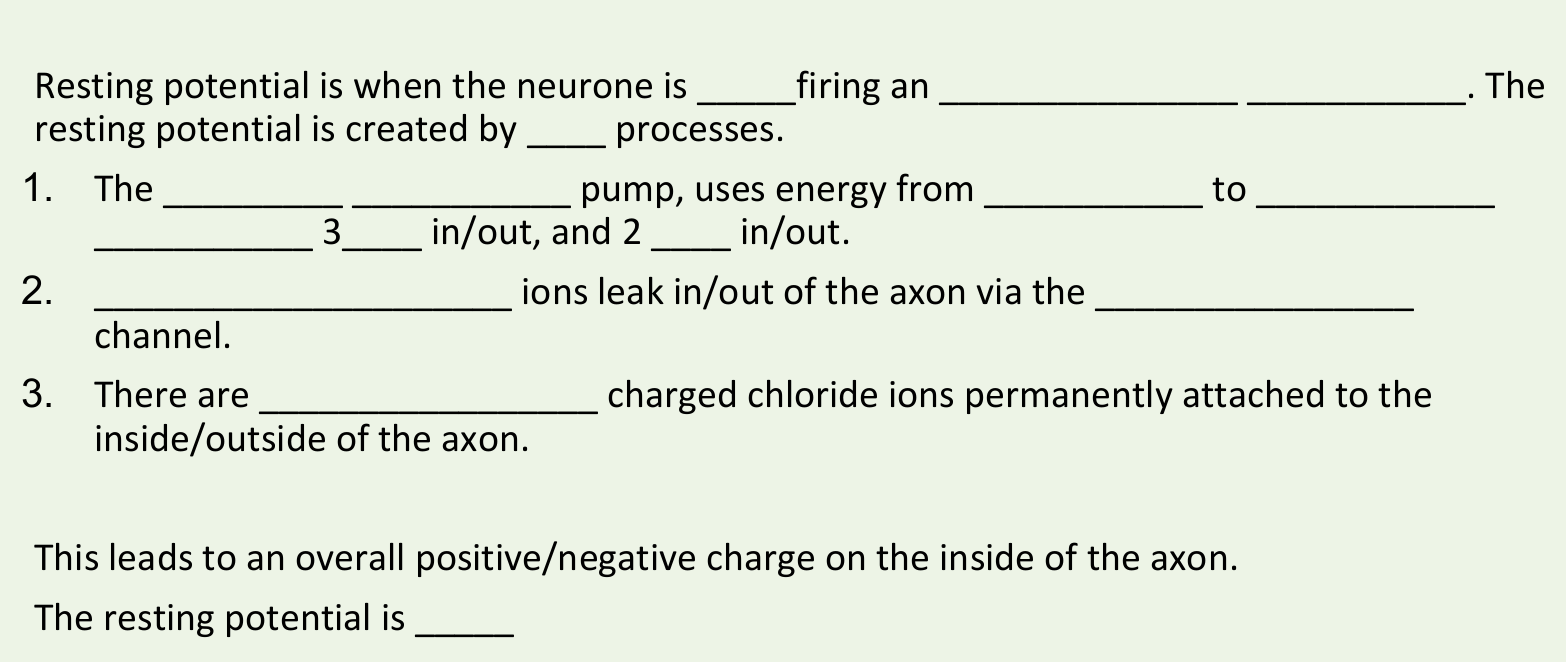
explain the principles of synaptic transmission
8 marks
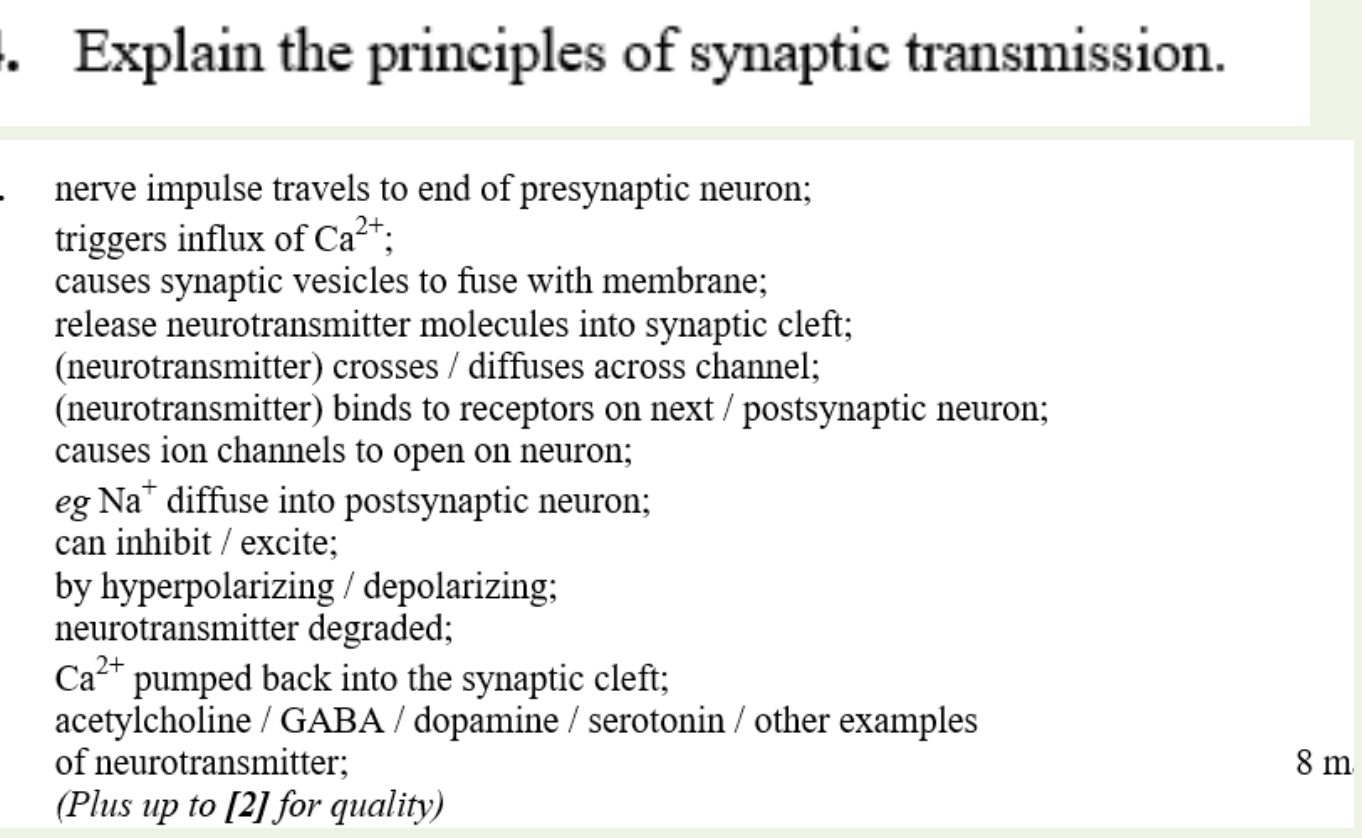
explain synaptic transmission- gapfill on phone
Enzyme ACHesterase breaks down ACH into acetyl + choline
Choline reabsorbed by the presynaptic neuron to make more acetyl choline
ACH esterase breaks down / destroys neurotransmittor after action potential is generated in the post synaptic neuron